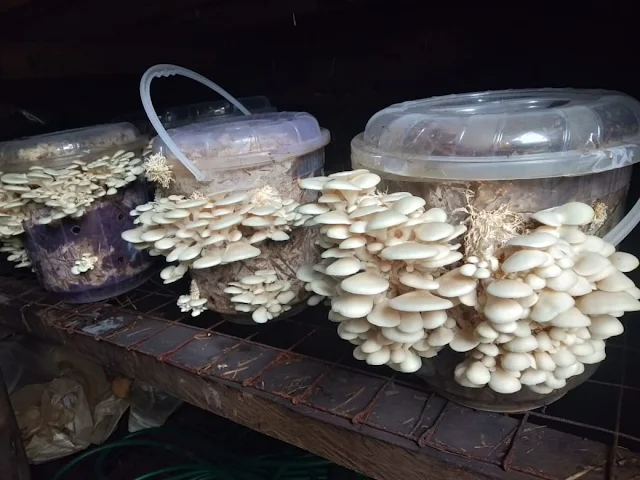Not so many Kenyans have realized how lucrative mushroom farming is yet. It is a pretty impressive investment only a handful of the informed farmers in Kenya are getting into. The demand for the delicious and healthy fungi is soaring, which means that the current supply does not come close to being at par with the demand. This is actually the strongest factor causing the high prices of mushrooms in Kenya.
As at June 2021, Zucchini Supermarket was selling a Kilo of button mushroom for almost KSh1,000.
 |
| Mushrooms for sale at Zucchini Supermarket |
We actually gave the facts and figures about the mushroom demand in Kenya and the supply quantities that our farmers currently have in the article How To Make Money With Mushroom Farming In Kenya Throughout the Year 2021. The current prices are at an all-time high, simply because the mushroom market in Kenya is seriously undersupplied. So if you are looking for a side hustle that is probably going to pay more than your day job, mushroom farming is the way to go.
 |
| Mushroom farming in Kiambu: Richfarm Kenya |
Most
people ask why mushrooms are expensive, being a fungus. One of the reasons is
that mushrooms, also known as the “fruit” of the fungi family, are rich in
antioxidants, lean proteins and essential vitamins. The other reason is that
mushroom farming is quite technical. The challenging manner of its growth,
being that they don’t grow in soil, inhibits people from taking it on as a
viable investment. This could be easily solved by a farmer getting the
technical knowhow from the experts at Richfarm Kenya.
Investment and returns of mushroom farming in Kenya
The
initial investment is on a basic minimum. Let us take oyster mushroom farming as an
example, for this is the easiest variety to produce in Kenya. With 1 square foot of space, they could easily produce 10kgs in a
year’s time. With the current wholesale price of ksh 400 per kilo, one is expected to
make ksh 400,000 in turnover from a 10’ by 10’ space. A small space is needed
for the mushroom growth. A garage will do just fine, and for those without one,
a grass thatched mud house will do. Remember to register for our weekly mushroom training sessions so you can learn how to make a simple
mushroom house.
All
this talk may give you a notion that mushroom farming is a walk in the park
that you would start now and boom! Reap the benefits tomorrow. This couldn’t be
farther from the truth, since the investment could be quite bumpy. For example,
the substrate needed ought to have been sterilized in the right conditions, failure
to which, the seeds wither.
After harvesting, mushrooms become highly perishable, one therefore needs a ready market post-harvest. The fresh mushrooms usually contain around 90% water content. Drying them has proven to preserve their nutrients and flavor hence one could invest in some drying equipment so as to extend their shelf-life.
Mushroom Market in Kenya
There are many individual buyers of mushrooms in Nairobi and other big town. Most of them buy in wholesale prices and resell the products to hotels or supermarkets. So we suggest that you carry
out a market survey as you start your mushroom production. Visit the local vegetable market and talk
to a few wholesalers whether they would be willing to buy the mushrooms from
you, once they are harvested. Inquire on the price they would be willing to buy
for.
Invest
in good packages, since the packaging system, goes a long way in maintaining
the mushrooms’ freshness. One should indicate the contact details, as well as
the farm’s location, so as to attract future customers. Make sure to only package
the good quality produce.
Place
placards in the local vegetable shops and around your neighborhood. Ask your
customers to spread a good word about your mushroom business to their family
and friends. Make sure to always emphasize all the nutritional benefits of the
mushrooms.
Farmers’
market provides a great way for the farmers since they get to sell a large part
of the harvest all at once. This is because market days attract large crowds,
who are looking to buy from the locals. You only need to set up a booth and you’re
ready to go.
On
large scale farming, farmers should look for companies that are producing
dietary supplements from plant extracts. As discussed earlier, mushrooms are
great immune boosters. Email them on their respective websites with your
information.
Now days, whatsapp groups offer a reliable platform for marketing your produce. Create a whatsapp group with your neighbors and update them when the produce is ready for sale. Share delicious mushroom recipes so as to entice people into cooking the mushrooms.
Mushroom farming training
In order to get the details and professional help on how to grow oyster and button mushrooms, it is advisable to visit some successful mushroom farmers in Kenya and learn from their experience. Richfarm Kenya also conducts a mushroom farming training every weekday and Saturday at their farm in Kamwangi, Kiambu. You can call them on 0724698357 to book a space for training.














